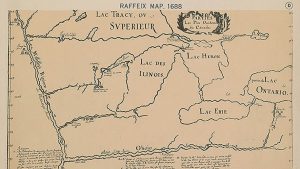This map, purported to have been created by Pierre Raffex in 1688 appears in a 1932 atlas by Charles O. Paullin. The map is centered on what are now called the Great Lakes.
What surprised me on this map was “Lac des Illinois.” Lake Illinois? From where I could see it looked like Lake Michigan.

Charles O. Paullin, Atlas of the Historical Geography of the United States, ed. John K. Wright. Washington, D.C.: Carnegie Institution, 1932. Digital edition edited by Robert K. Nelson et al., 2013. http://dsl.richmond.edu/historicalatlas/.
I was curious about the reference to the lake as “Lake Illinois” instead of Lake Michigan. At this point, I don’t know if the description of the lake with this term is an aberration or if there was a time when the lake was know as Lake Illinois. It is also possible that the reference is a simple mistake. I don’t know at this point–and that’s not really the purpose of this post.
The reference got me to thinking about what genealogists should do when they see something they think is wrong:
- Consider the source. Is Raffeix’s map accurate in other ways? Are there other problems with it? Is Raffeix generally known to have been accurate?
- Consider the time. Was the name in use when the map was drawn up.
- Consider that the reference could be a mistake or an oversight.
- Is the map an accurate rendering of the original? In this case, the image on this blog post is made from a digital image on the website that was made from the 1932 book which was made from the original or a copy of the original. That’s several generations removed from the original.
- Consider that you don’t know everything. Maybe Lake Michigan was known as Lake Illinois. Even if a person spent their entire life on the lake, it doesn’t mean that they know everything about the lake–especially things three centuries before their lifetime.
And, consider that place names can change.
All of these things are things to think about even if the reference on the map was an aberration.
And–it goes to show you that you can always learn something from looking at old maps.
Jane Schapka says:
Perhaps the addition of the word “Des” (French for “of the” or “belonging to” between Lac and Illinois makes a difference. The other Great Lakes do not have “Des” between “Lac” and their name.
Jane Schapka says:
Well, My guess was pretty close, but here is a better answer:
“The first Europeans to see Lake Michigan were French traders and explorers in the 1600’s. One of which, Samuel de Champlain (1567?-1635), who mapped much of northeastern North America, called Lake Michigan the Grand Lac. It was later named “Lake of the Stinking Water” or “Lake of the Puants,” after the people who occupied its shores.
In 1679, the lake became known as Lac des Illinois because it gave access to the country of the Indians, so named. Three years before, Claude-Jean Allouez (1622-1689), a French Jesuit missionary, called it Lac St. Joseph, by which name it was often designated by early writers while others called it Lac Dauphin.“
Citation:
“Lake Michigan: History, Facts & Figures,” Southwest Michigan Directory (www.swmidirectory.org : viewed 26 May 2018).